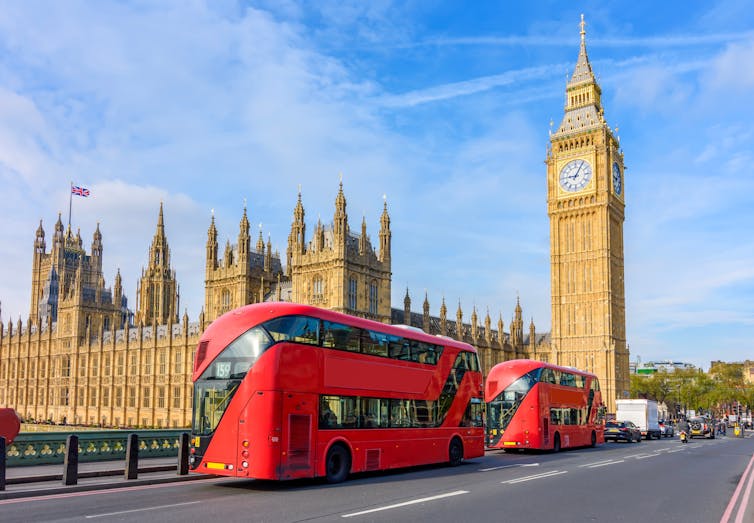For the first time in 14 years, it was a Labour chancellor who delivered the UK budget. And for the first time ever, that chancellor was a woman. But Rachel Reeves faces an almighty task: plugging a £40 billion spending gap in the knowledge that pre-election promises not to raise the main taxes are still fresh in people’s memories.
Growth was the buzzword of the election campaign – Reeves now had to lay her cards on the table. So here’s what our panel of experts made of the plans:
More challenges for employers and small businesses
Shampa Roy-Mukherjee, Associate Professor in Economics, University of East London
The budget introduces £40 billion in tax hikes and, in some areas, spending cuts that will put pressure on the economy and business in particular. But it also reflects the government’s focus on economic growth, with policies intended to stabilise finances while addressing some of the concerns of small businesses.
The chancellor has retained her commitment to preserve the rates of income tax, employee national insurance and VAT. But a notable change is the increase in employers’ national insurance contributions (NICs) from 13.8% to 15%.
There was also a reduction in the secondary threshold, which is the amount at which the employer starts paying NI on each employee, from £9,100 to £5,000. Altogether this will raise £25 billion annually but will significantly impact many businesses that will now face higher wage bills.
The national living wage is also rising by 6.7% to £12.21 per hour in April 2025, boosting incomes for about three million workers but again increasing costs for many businesses. These rising taxes and wage increases, alongside incoming employment regulations, will strain businesses, particularly in sectors with high labour demands.
To offset some of these pressures, the employment allowance, which allows some smaller employers to reduce their NICs, has been raised from £5,000 to £10,500. The chancellor said that over 1 million employers will not see their NICs bill rise as a result.
Small businesses in retail, hospitality and leisure, where profits have been hit as consumers struggle with the cost of living, will benefit from a 40% business rate relief on properties up to £110,000. Other supportive measures include a continued freeze on fuel duty, which will aid logistics and transport costs. Corporation tax remains fixed at 25%.
Higher wages for three million, but it could cost more to get the bus to work
The biggest change for those on low incomes was an increase in the national minimum wage (for 18 to 20-year-olds) of 16.3%, from £8.60 to £10 an hour, and an increase in the national living wage (for employees aged 21 and over) of 6.7%, from £11.44 to £12.21, from April 2025. This will lead to a pay rise for more than 3 million workers.
Business associations warn that this will cause job losses, particularly in hospitality and the care sector, where many employees earn the minimum wage. But a large body of research has not found a negative effect of minimum wages on employment.
There is some evidence that earlier minimum wage rises caused an increase in the number of zero-hours contracts in social care, as firms tried other ways to reduce wages. However, the new employment rights bill introduced earlier in October would limit the use of zero-hours contracts in this scenario.
The budget could have an indirect effect on pay packets though. The effect of the change to employer NICs will be greater in sectors with more low-paid workers, such as hospitality, and employer associations have warned that it will risk jobs. There is also some evidence that in the long term, firms pass some of these costs on to employees by reducing their wages.
However, the minimum wage increase will reduce the capacity for firms to reduce wages. And any long-term effect would also be offset by lower income taxes that will come after 2028 when the chancellor has said she will increase the threshold at which people starting paying tax.
So if wages and profits fall because of increased contributions, then the amount Reeves raises will be lower than expected, because income and corporation tax receipts will be hit.
Another indirect factor affecting incomes is the cost of getting to work. The fuel duty freeze will continue, but the bus fare cap will increase from £2 to £3. Lower-paid workers and jobseekers are much more likely to use the bus than those with higher incomes, who are more likely to drive, but the cost of bus travel increased much more than the cost of train travel or petrol over the last parliament.
 At the next stop they’re putting up bus fares.
Mistervlad/Shutterstock
At the next stop they’re putting up bus fares.
Mistervlad/Shutterstock
The fare cap reversed some of this increase, and some evidence shows that it led to more people travelling by bus. But the new £3 cap will only last until the end of 2025, which may be too soon to see much effect.
A downpayment on growth – but probably not quickly
Linda Yueh, Adjunct Professor of Economics, University of Oxford
The chancellor declared that the government will “invest, invest, invest”. This is an important enabler of economic growth.
But, the country’s creditors need reassuring, so Reeves also announced two new fiscal rules that aim to achieve that balance of allowing the government to borrow to invest (and generate growth), but not to pay for day-to-day spending.
Specifically, the investment rule permits borrowing to invest and the stability rule requires day-to-day spending to be paid for by taxes. Both rules support the government’s growth aims while trying to reassure the country’s creditors that the borrowing will pay off by generating future growth – and also higher tax receipts with which to repay that borrowing.
But spending watchdog the Office for Budget Responsibility (OBR) has downgraded the UK’s GDP growth outlook from 2% to 1.8% in 2026, and to 1.5% in 2027 and 2028. The OBR’s forecast of slower growth highlights the impact of the £40 billion of tax increases, which dampens economic activity.
This underscores the government’s challenge of investing to grow while at the same having to raise taxes to balance the books when it comes to its daily spending. In particular, the OBR’s assessment of slowing growth towards the middle of this parliament raises questions about how long it will take for the investment-fuelled growth to materialise.
It may be that five years is still too short a period. Many physical investments require planning and those reforms could also take a while. Moreover, getting investment projects under way requires scoping, and private investors will want time to assess before joining the government in energy projects.
But this budget is certainly a start on a much-needed growth strategy.
Good news on public investment – emerging industries could benefit
Phil Tomlinson, Professor of Industrial Strategy, University of Bath
The key budget change related to the chancellor’s fiscal rules. By redefining how public debt is calculated, Reeves has been able to increase public investment by around £100 billion. The new fiscal rules have gone not as far as some economists have advocated – but they are a welcome step in the right direction.
Investment was the core focus of the budget. For decades, the UK has suffered from low investment and weak productivity compared to other leading economies. Since 1990, the UK’s investment gap with the average across rich countries in the Organisation for Economic Co-operation and Development (OECD) has been around £35 billion a year – the UK now ranks 28th of 31 OECD countries on business investment. British workers are using outdated kit and so are less productive. This has meant a stagnant economy and lower living standards.
So, the budget’s plans to boost investment in the UK’s crumbling infrastructure and public services and to support the new industrial strategy are a positive move. The latter should see additional funding to support emerging tech industries, such as artificial intelligence, cyber and clean energy. And this public investment should “crowd in” additional private investment.
 Clean energy boost?
StudioFI/Shutterstock
Clean energy boost?
StudioFI/Shutterstock
In the long run, these investments should pay for themselves. For instance, the Office for Budget Responsibility estimates that a sustained increase in public investment of 1% of GDP increases that GDP by 0.5% after five years and more than 2% after ten to 15 years.
The rise in employer national insurance contributions will increase business’s operating costs, especially those in the care and hospitality sectors. But paradoxically, in the long run, it may encourage some businesses (in sectors where it is feasible) to invest in new labour-saving capital equipment.
Read more: Rachel Reeves is the UK's first female chancellor. Here's why that's so significant
More reaction to be published soon.
Karen Bloor receives funding from the NIHR policy research programme to conduct responsive analysis for the Department of Health and Social Care,
Phil Tomlinson receives funding from the Engineering and Physical Sciences Research Council (EPSRC) for Made Smarter Innovation: Centre for People-Led Digitalisation.
Rachel Scarfe is a member of the Labour Party.
Jonquil Lowe, Linda Yueh, and Shampa Roy-Mukherjee do not work for, consult, own shares in or receive funding from any company or organisation that would benefit from this article, and have disclosed no relevant affiliations beyond their academic appointment.

 6 months ago
284
6 months ago
284 
















 English (United States) ·
English (United States) ·